Table of Contents
The construction work for Phase-1 of the Rs 12,020-crore Surat Metro rail project has begun after tenders worth over Rs 3,002 crore for various civil works.
1.Metro: The Viability
2.Surat Metro : All Stations List
3.Surat Metro : General Information & Details
4.The other details are as under:
5.Line, Routes and Stations
6.Maintenance Facilities
7.Benefits & Infrastructure
8.Rolling Stock
9.System Specifications
10.Key Figures
11.Key Figures Metro Fares (Ticket Prices)
12.Latest Update
12.
Surat is located 284 Kms south of Gandhi Nagar, 265 Kms of Ahmedabad and 289 Kms north of Mumbai. The economy of the entire city is based mainly on two industries, the textile industries of manmade fibers/fabrics and the diamond cutting and polishing industry.
It is one of the most dynamic cities of India having faster growth rate due to immigration from various parts of Gujarat and other States of India too. National Highway-8 (NH-8) passes within 16 Kms. of municipal boundaries of Surat and is located midway on the Ahmedabad-Mumbai route.
The city is well known for its diamond and textile industries and popularly called the Diamond City of India. It is famous for its diamond cutting and polishing and more than 90 percent of crude diamond across the world is processed here. Surat is a popular shopping centre for apparels and accessories in India.
It is the eighth largest city by population and ninth largest urban agglomeration in India. It is the administrative capital of the Surat district. According to a study conducted by Economic Times, Surat is expected to be the world’s fastest growing city till 2035.
Presently is the 4th fastest growing city of the world and fastest growing city of India. The city registered an annualised GDP growth rate of 11.5% over the seven fiscal years between 2001 and 2008.
Surat has been awarded as the ‘best city’ by the Annual Survey of India’s City-Systems (ASICS) in 2013. The city has been selected as the first smart IT city in India which is being constituted by the Microsoft CityNext Initiative tied up with IBM.
Surat is listed as the second cleanest city of India as of 21 August 2020 according to the Swachh Survekshan 2020. The city has various engineering plants like Essar, Larsen and Toubro and RIL. Surat won the Netexplo Smart Cities Award 2019 with UNESCO in the resilience category.
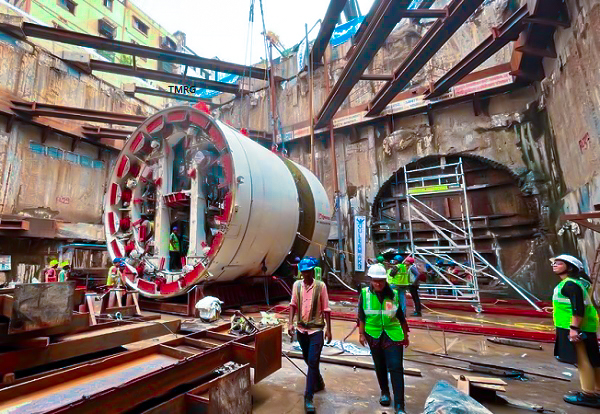
1.Metro: The Viability
Surat is one of the oldest inhabited cities in the world and densely populated with an average 13680 persons/sq.km accommodating about 44.67 Lakhs people as per census 2011. Average decadal growth of population of Surat since 2001 to 2011 was about 55.29%. Surat is spread over an area of 326.515 sq. kms.
Surat’s high population growth rate, coupled with high economic growth rate has resulted in an ever increasing demand for transport creating excessive pressure on the existent transport system. With high growth in transport demand over the years, congestion on roads has been increasing due to phenomenal rise in private transport.
Absence of an efficient full-fledged public transport system coupled with rapid growth in the use of personalized vehicles has led to high consumption of fossil fuel and increase in environmental pollution. Surat has also been selected as one of the hundred Indian cities to be developed as a ‘Smart City’. The existing network of public transport systems including dedicated BRTS needs to be strengthened further in order to cope-up with rising demand of transport system.
2.Surat Metro : All Stations List
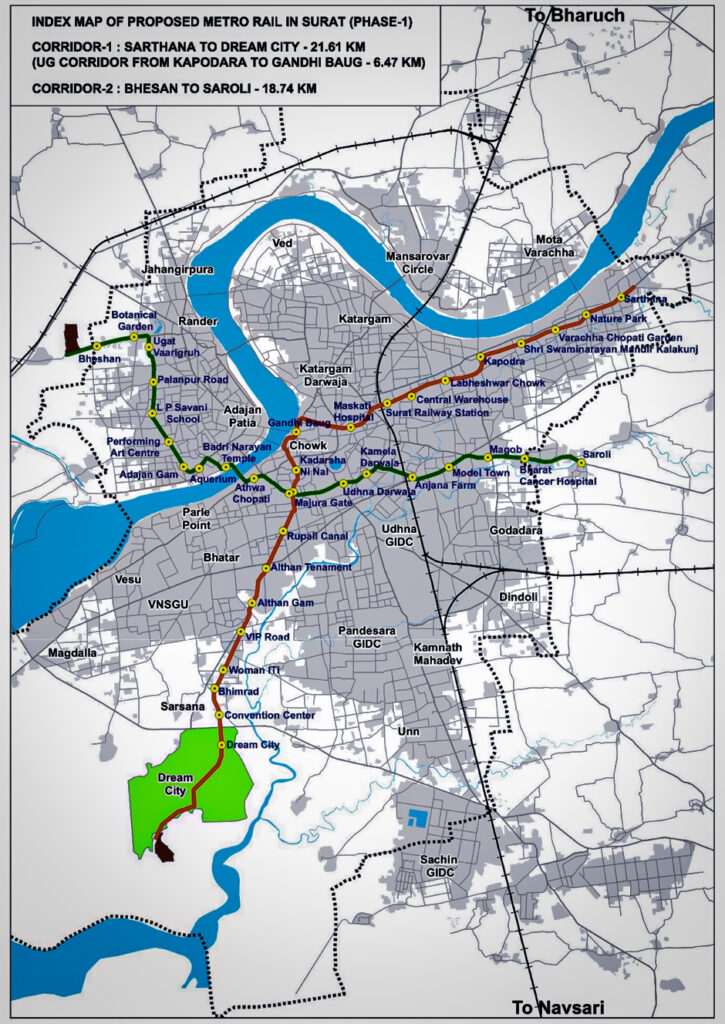
Line 2 (Bhesan – Saroli)
- Bhesan
- Megh
- Botanical Garden
- Ugat Vaarigruh
- Palanpur Road
- LP Savani School
- Performing Art Centre
- Adajan Gam
- Jagdishchandra Bose Aquarium
- Badri Narayan Temple
- Athwa Chopati
- Majura Gate (Interchange to Line 1)
- Udhna Dawaja
- Kamela Darwaja
- Anjana Farm
- Model Town
- Magob
- Bharat Cancer Hospital
- Saroli
Line 1 (Sarthana – DREAM City)
Length: 21.61 km
Alignment: Elevated (15.14 km) & Underground (6.47 km)
No. of Stations: 20
Line 2 (Bhesan – Saroli)
Length: 18.74 km
Alignment: Elevated
No. of Stations: 18
Stations:
Stations:
Line 1 (Sarthana – DREAM City)
- Sarthana
- Nature Park
- Varachha Chopati Garden
- Shri Swaminarayan Mandir Kalakunj
- Kapodra
- Labheshwar Chowk
- Central Warehouse
- Surat Railway Station
- Maskati Hospital
- Gandhi Baug
- Kadarsha Ni Nal
- Majura Gate (Interchange to Line 2)
- Rupali Canal
- Althan Tenament
- Althan Gam
- VIP Road
- Woman ITI
- Bhimrad
- Convention Center
- DREAM City
3.Surat Metro : General Information & Details
To cater to needs of most prospective and fastest growing city of India the following two Metro Corridors have been identified for its inclusion in Surat Metro Rail Network (Phase-1)
| Sr. No. | Corridor | Underground | Elevated /At Grade (Kms) | Total (Km) |
| 01 | Phase-1 Corridor-1 (Sarthana to Dream City) | 6.47 Kms | 15.14 Kms | 21.61 Kms |
| 02 | Corridor-2 (Bhesan to Saroli) | — | 18.74 Kms | 18.74 Kms |
| Total | 6.47 Kms | 33.88 Kms | ms |
The Detailed Project Report (DPR) has been prepared for the proposed 02 (two) corridors extending in North, South, East, West and Central parts of Surat city, as such most parts of Surat are covered with these proposed corridors. The project comprises various important and prominent areas along the proposed corridors under Surat Metro Rail Network as per details as under.
4.The other details are as under:
| Project | Metro rail for N-S and E-W corridor for Surat City |
| Location | Surat City (Gujrat) |
| Client | GMRC |
| Total Cost of Phase 1 | INR 12,800 Crore |
| Total Phase 1 length | 40.35 Km |
| Total No. of Stations | 37 |
| Corridor 1 | Sardhana to Khajod where 15.14 Km is elevated and 6.47 Km is underground section |
| Corridor 2 | Bhesan to Saroli. 18.74 Kmis elevated section. |
| Interchange / Depot(D) | Majura gate / Khajod (D) & Bhesan (D) |
| Worked Involved | Feasibility Studies |
| Seismic Zone | Zone III |
| Soil | Alluvial Soil |
| Duration of Construction | 36 Months |
| Consultants appointed till date | DMRC – DPR CoE, CEPT University – Traffic Studies |
The Government of India approved the Surat Metro project in March 2019. Gujarat Metro Rail Corporation (GMRC), a special purpose vehicle (SPV) jointly owned by the governments of India and Gujarat, is responsible for the implementation of the project.
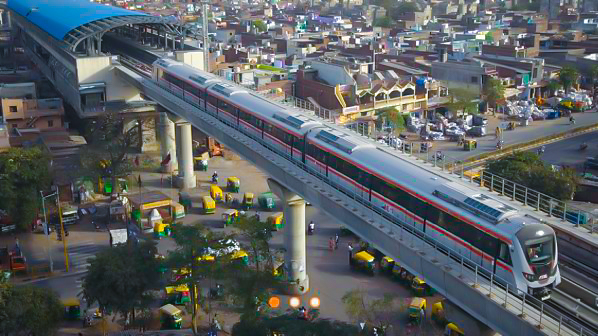
5.Line, Routes and Stations
The 40.35km-long first phase of the Surat Metro will feature 38 stations across two corridors. The plan includes 32 elevated stations and six underground stations. The first corridor is proposed to be 21.61km long, including a 15.14km-long elevated section and a 6.47km-long underground section. It will run from Sarthana to Dream City, whereas the 18.74km-long, entirely elevated second corridor will run from Bhesan to Saroli.
The first corridor will have 20 metro stations, linking Sarthana, Nature Park, Kapodra, the Labheshwar chowk area, Central Warehouse, Surat Railway station, Maskati hospital, Gandhi Baug, Majura Gate, Roopali canal, and Dream City. Stations at Bhesan, Ugat Vaarigruh, Palanpur Road, LP Savani School, Adajan Gam, Aquarium, Majuragate, Kamela Darwaza, Magob, and Saroli will be connected through the second corridor. The Majura Gate station will serve as the interchange for the two corridors.
The planned corridors will have multi-modal integration of the metro rail with other modes of transportation, including feeder buses, intermediate public transport (IPT), and non-motorised transport (NMT). The corridors will connect the city’s most congested, significant, and densely populated areas.
6.Maintenance & Facilities
The first phase will have two maintenance depots, one in each corridor, at Dream City and Bhesan. Solar equipment will be installed at the depots to harness solar energy.
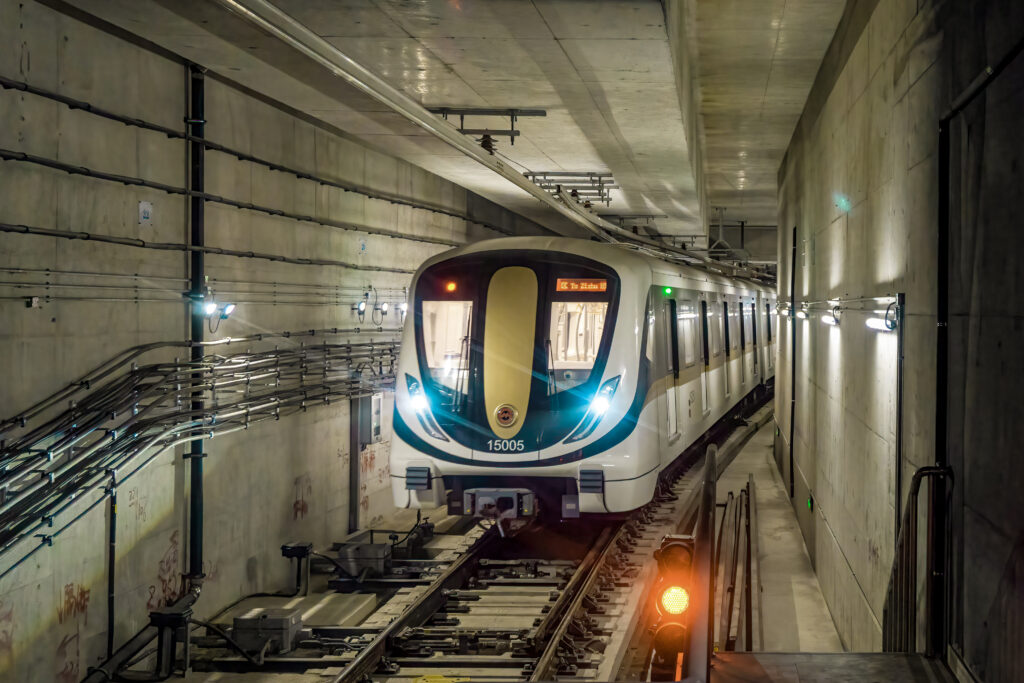
7.Benefits & Infrastructure
Benefits
The Surat Metro project aims to provide a reliable and safer public transportation system that will address traffic congestion problems and reduce delays on major travel corridors, in Surat. The integrated mass public transit system is expected to reduce accidents and pollution while decreasing energy usage. It is expected to offset 40,000t of carbon dioxide (CO2) emissions.
Infrastructure
Surat Metro will have a 1,435mm standard gauge track for both the corridors, which will support operations at a maximum speed of 80km/h, and a design speed of 90km/h. The ticketing system will feature an automatic fare collection system comprising a computerised contactless smart token for a single journey, and contactless smart cards for multiple journeys along the route. It will feature an integrated telecommunication system comprising fibre optic cable, train radio, supervisory control and data acquisition (SCADA), and a public address system.
The signalling system will comprise continuous automatic train control (CATC), with cab signalling and an automatic train operation (ATO) system. Automatic train supervision equipment will be installed to enhance operational safety.
8.Rolling Stock
Trainsets with stainless steel car bodies are being considered for the metro project, according to the detailed project report (DPR). The preferred configuration is three-car trains, and each train is expected to have a carrying capacity of approximately 764 passengers, comprising 136 seated passengers and 628 standing passengers.
The trains will be outfitted with train-based monitor and control systems such as train control and management system (TCMS), or train integrated management system (TIMS). The maximum operating speed of the trains is 80km/h
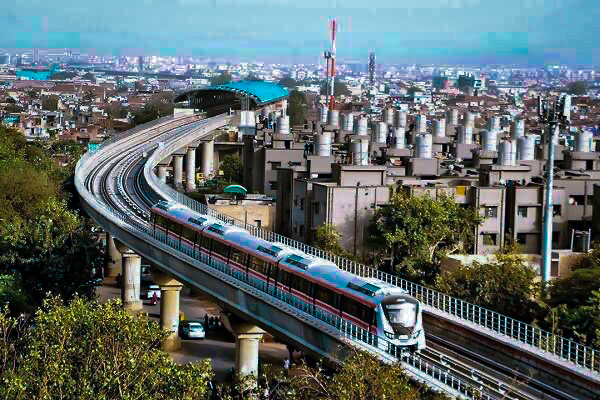
9.System Specifications
- Top Speed: 80 kmph
- Average Speed: 40 kmph
- Track Gauge: Standard Gauge 1435 mm
- Electrification: 750 V DC Third Rail
- Signalling: Communications-based Train Control (CBTC)
10.Key Figures
- Operational Line : 0 km
- Under Construction: 18.6 km
- Approved Line: 40.35 km
- Estimated Cost: Rs. 12,020.32 crore
- Estimated Daily Ridership: 2.20 lakh/day (2027)
11.Metro Fares (Ticket Prices)
Surat Metro’s fare structure, prices and rules have not been announced yet. That will be finalized closer to the start of commercial operations. GMRC plans to use the latest technologies for its automatic fare collection (AFC) system to allow QR codes and Near Field Communication (NFC) phones to utilize the system.
12.Latest Update
The construction work for Phase-1 of the Rs 12,020-crore Surat Metro rail project has begun after tenders worth over Rs 3,002 crore for various civil works, including those for the underground section being awarded by the Gujarat Metro Rail Corporation (GMRC). Work has been started on the 21.58-kilometre corridor between Sarthana and Dream city.
GMRC has awarded tenders worth Rs 3,002 crore, including tenders for the underground section, which will be built at a cost of over Rs 1,870 crore. The first tender for building the 11.6-kilometre elevated section from Dream City to Chowk Bazar has been awarded to a joint venture between M/s Sadbhav Engineering Ltd and SP Singla Constructions Pvt Ltd. Work for the six-odd kilometres of the underground section, which is on the same corridor between Dream City and Sarthana, has been allotted in two packages.
M/s JK Infra Projects have been awarded the contract to construct the underground section between Chowk Bazar to Surat Railway Station (3.6 km) at the cost of Rs 943 crore.A joint venture between Gulermark and Sam India Builtwell has been awarded a Rs 929-crore contract to build the underground section between Kapodara to Central Warehouse (3.46 kms). A fourth tender of Rs 350 crore has been awarded to M/s ITD Cementation India for constructing the Dream City Depot.
The scope of work will also include construction of Operations Control Centre and metro Bhavan headquarters at Dream city.

The Phase-1 of Surat Metro was sanctioned on June 6, 2019, for a total length of 40.35 kilometres. Prime Minister Narendra Modi laid the foundation stone and conducted the bhoomi pujan virtually on January 18, 2021. The project consists of two elevated corridors with a total of 38 stations. The longest corridor of about 21.58 kilometres is between Sarthana and Dream city. This section with 20 stations also has 6.47 kilometres of underground network from Chowk Bazar to Labheshwar Chowk.
The second corridor of 18.74 kilometres is between Bhesan and Saroli and has 18 stations. Of the Rs 12,020 crore needed for Phase-1 constructions, France’s AFD and Germany’s KfW shall be providing a soft loan of Rs 5,434 crore, which will be 57 per cent of the total cost.
The central and state governments will pitch in with Rs 1,487 crore each. The Phase-1 of the project is targeted to be completed by March 2024. Over 676 families are expected to be affected by the Surat Metro project and the GMRC has sanctioned Rs 375 crore for rehabilitation work. The on-site identification and finalisation of affected families are in process. The actual number of affected families will be calculated after the finalisation of alignment, on-site demarcation and detailed site survey.

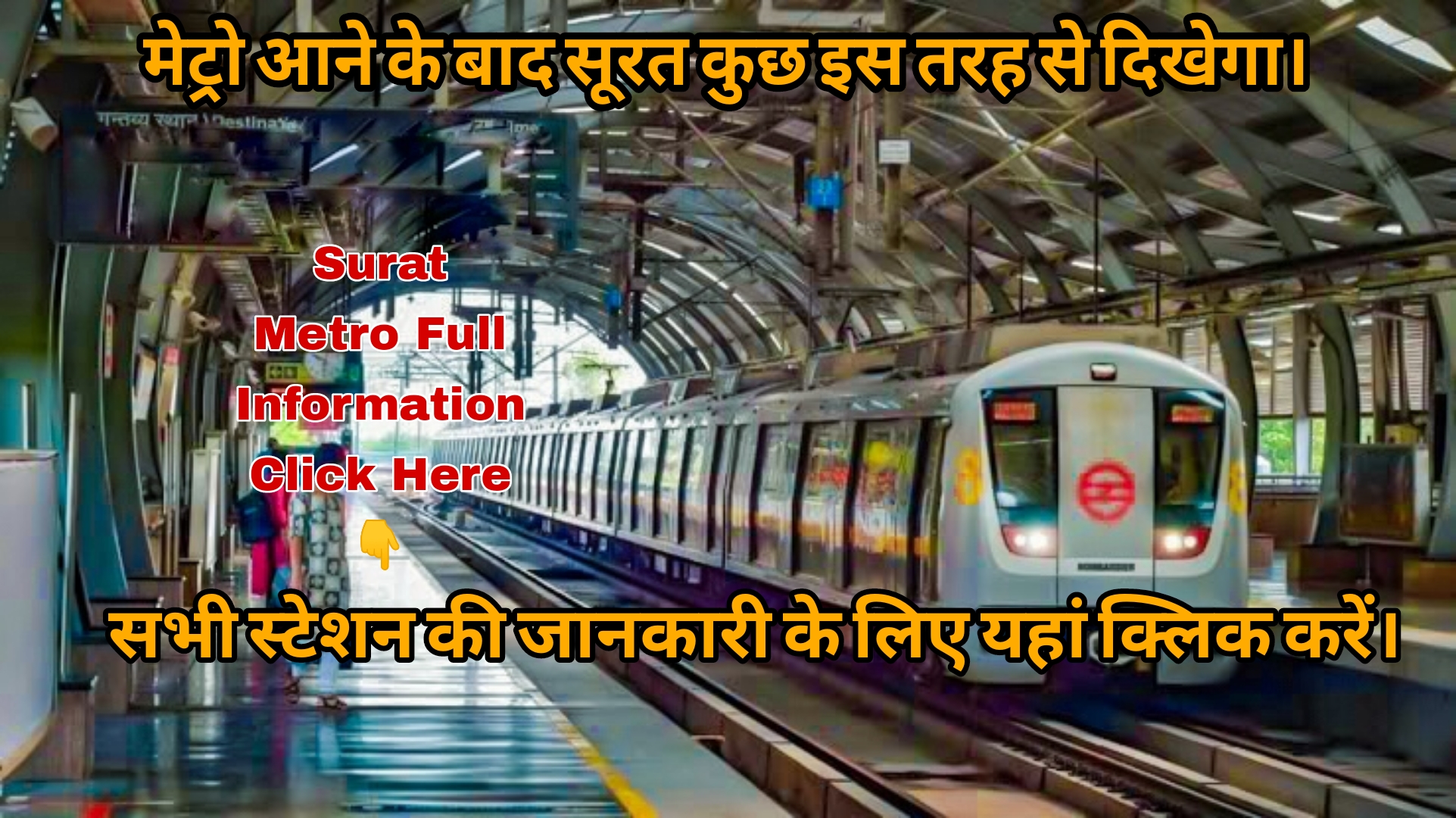
2 thoughts on “Surat metro: Information ,2 Main Route, Maps, Fares, & Updates”